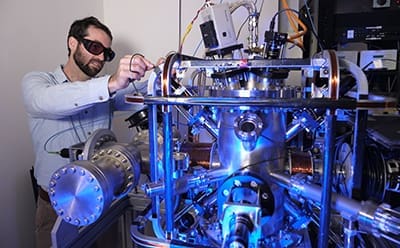Click on video to lean how the Noble Gas Facility operates
IT IS now possible to date groundwater samples from one million years to just a few decades old, under new tools now available to Australian scientists.

University of Adelaide researcher Dr Rohan Glover with the Atom Trap Trace Analysis (ATTA) facility at the Institute for Photonics and Advanced Sensing, University of Adelaide
The unique new Atom Trap Trace Analysis (ATTA) facility at the University of Adelaide uses advanced laser physics to count individual atoms of the noble gases, such as Argon and Krypton, that are naturally found in groundwater and ice cores.
Measuring the ultra-low concentrations of these radioactive noble gases allows researchers to understand the age, origin and interconnectivity of the groundwater and how it has moved underground through space and time.
A collaboration between CSIRO and the University of Adelaide, the facility is the first of its kind in the Southern Hemisphere.
Combined with the CSIRO’s complementary Noble Gas Facility at the Waite campus in Adelaide, gives Australia one of the most comprehensive noble gas analysis capabilities in the world.
“Australia relies on its groundwater for 30% of its water supply for human consumption, stock watering, irrigation and mining,” says Professor Andre Luiten, Director of the University’s Institute for Photonics and Advanced Sensing which houses the ATTA facility.
“With climate change and periods of prolonged drought, surface water is becoming increasingly more unreliable and the use of groundwater is rising. We need to make sure it’s sustainable.”
“Because noble gases don’t easily react chemically, they are the gold standard for environmental tracers to track groundwater movements. Before this new facility, researchers wanting to measure these ultra-low concentrations of noble gases had to rely on a very small number of overseas laboratories which can’t meet demand for their services.”
ATTA’s analytic capability will also allow researchers to look further into the past of Antarctica’s climate, building understanding of global environmental change.
CSIRO Senior Principal Research Scientist Dr Dirk Mallants says the new ATTA facility will enable researchers to determine how old groundwater is from decades and centuries up to one million years.
“This allows us to understand the sources of water, where it comes from and what the recharge rates are,” says Dr Mallants. “That then allows us to make decisions about sustainable extraction. This is critical where development of any kind might use or impact groundwater systems – from urban development where groundwater systems are used to supply communities, to agricultural and mining development.
“It will provide Australian researchers, government and industry with unique capability of collaboration on national water challenges.”
The new ATTA facility is partially funded under the Australian Research Council’s Linkage, Infrastructure, Equipment and Facilities scheme.
Energy, mining and resources is a key industry engagement priority for the University of Adelaide and environmental sustainability is a research focus.
The CSIRO and the University of Adelaide in 2017 announced a new agreement to work together to tackle some of the big issues facing Australia and the region.
The two organisations agreed to build collaborations to advance research in key areas of mutual strength, with significant potential benefit to the Australian economy, society and environment.
Source: University of Adelaide.

Such Important Research on a National Resource that Regional Australia relies so heavily on , more Relevant than ever with the conflicting interests of competing industries .
Our response to Climate Change must be based on genuine research rather than than the emotion based hysteria being peddled by much of the City based media .
How does this compare with the work done at ANSTO some 20 years ago?
A great step forward. Any chance of researching the aquifers in some of the oldest underground areas of the world in the massive Beetaloo basin in the NT?
Although water for the population is a priority.
This is good news for the rural industries of the Surat Basin where these tracers could be used to identify or otherwise the inter-connectivity between the coal seam gas formations and the un-confined and confined aquifers upon which our water bores and future groundwater supplies depend.
The information will assist in the modelling of the processes by why gas is being released in water bores near or within coal seam gas fields and the extent to which existing and proposed new water bores have or will be “impaired” by coal seam gas extraction and by inadequate cementing of gas wells in locations where potential transfer of gas-saturated water to aquifers important to agriculture could occur.
This is an issue that has not been addressed by the Queensland Government’s Office of Groundwater Impact Assessment since the first report in 2012 and needs to be resolved through independent assessment before the Department of Environment and Science approves the current draft Surat Basin Cumulative Underground Water Impact Report (UWIR).
It is also an issue that needs to be addressed by scientists assisting the amalgamated Departments of Water and Environment in Canberra, viz. the independent Expert Scientific Committee before the current UWIR is approved by both levels of government.